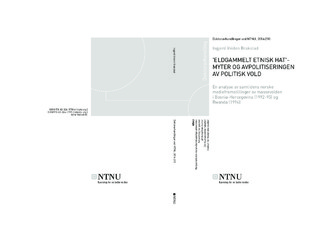| dc.contributor.advisor | Kaldal, Ingar | |
| dc.contributor.advisor | Kjeldstadli, Knut | |
| dc.contributor.author | Brakstad, Ingjerd Veiden | |
| dc.date.accessioned | 2017-01-12T10:02:38Z | |
| dc.date.available | 2017-01-12T10:02:38Z | |
| dc.date.issued | 2016 | |
| dc.identifier.isbn | 978-82-326-1759-3 | |
| dc.identifier.issn | 1503-8181 | |
| dc.identifier.uri | http://hdl.handle.net/11250/2427098 | |
| dc.description.abstract | Sammendrag av avhandlingen
Avhandlingen handler om hvordan myten om eldgammelt etnisk hat kom til uttrykk i samtidens norske pressedekning av folkemordene i Bosnia-Hercegovina (1992-95) og Rwanda (1994), og søker svar på hvordan vi som fjerne tilskuere forstår massevold. Den undersøker myter tilknyttet stedene der volden ble utført, og analyserer hvordan disse mytene formet måten voldshandlingene ble forstått på. Avhandlingen viser hvordan bildet av etnisk krig og eldgammelt hat førte med seg en forestilling om uunngåelig, emosjonelt drevet, apolitisk vold med bred folkelig støtte.
Folkemord er en overmakts planlagte, ensidig angrep på en gruppe sivile. Innenfor rammen av eldgammelt etnisk hat forvandles imidlertid en politisk, ensidig forbrytelse til en alles kamp mot alle. Voldens politiske og institusjonelle karakter usynliggjøres, og gjerningspersonenes definisjon av hendelsene som uunngåelige og skjebnebestemte videreformidles. | nb_NO |
| dc.description.abstract | Summary of the thesis
The thesis examines how the myth of ancient ethnic hatred was expressed in Norwegian media accounts of the genocides in Bosnia-Herzegovina (1992-1995) and Rwanda (1994), and explores bystander perceptions of mass violence. It identifies myths connected to the place the violence was carried out, and analyses the ways in which these myths shaped how the violence was perceived by the outside world. The thesis shows how the image of ethnic war and ancient hatred led to an understanding of the violence as inevitable, emotionally driven, apolitical, and broadly supported by the majority of the population.
Genocide is a planned, one-sided attack carried out by an authority against a group of civilians. Within the narrative frame of ancient ethnic hatred, however, a political, one-sided crime is transformed into an all against all fight. The political and institutional nature of the violence is obscured, and perpetetrator characterisations of the violence as inevitable are reproduced. | nb_NO |
| dc.language.iso | nob | nb_NO |
| dc.publisher | NTNU | nb_NO |
| dc.relation.ispartofseries | Doctoral theses at NTNU;2016:210 | |
| dc.title | 'ELDGAMMELT ETNISK HAT'- MYTER OG AVPOLITISERINGEN AV POLITISK VOLD En analyse av samtidens norske medieframstillinger av massevolden i Bosnia-Hercegovina (1992-95) og Rwanda (1994) | nb_NO |
| dc.type | Doctoral thesis | nb_NO |
| dc.subject.nsi | VDP::Humanities: 000::History: 070 | nb_NO |
